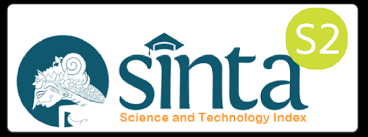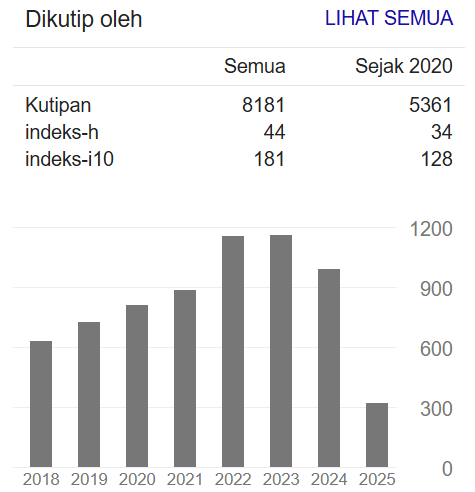EXPLORING SAFE AND HARMFUL SKINCARE INGREDIENTS IN PREGNANCY: AN UMBRELLA REVIEW
DOI:
https://doi.org/10.34011/jmp2k.v35i3.3108Keywords:
dermatologi dalam kehamilan, kesehatan ibu, kesehatan janin, kehamilan, perawatan kulit yang amanAbstract
Kehamilan menyebabkan perubahan hormonal dan fisiologis yang memengaruhi kondisi kulit, sehingga banyak ibu hamil mencari solusi perawatan kulit yang aman. Beberapa senyawa aktif, seperti retinoid dan hidrokuinon, diketahui memiliki risiko teratogenik, sedangkan senyawa lain, seperti benzoil peroksida dan asam azelat, masih memerlukan evaluasi lebih lanjut terkait keamanannya.Penelitian ini merupakan tinjauan payung (umbrella review) yang menganalisis 11 artikel berbasis tinjauan literatur yang dipublikasikan dalam bahasa Inggris atau Indonesia dan tersedia dalam teks lengkap. Sumber data diperoleh dari tiga basis data: PubMed, ScienceDirect, dan ResearchGate (periode 2011–2024). Penilaian kualitas artikel dilakukan menggunakan instrumen SANRA (Scale for the Assessment of Narrative Review Articles).Hasil menunjukkan bahwa asam azelat, klindamisin topikal, eritromisin topikal, benzoil peroksida, dan niasinamida umumnya aman digunakan selama kehamilan. Sebaliknya, retinoid, hidrokuinon, dan minosiklin oral harus dihindari karena potensi teratogeniknya. Beberapa bahan lain, seperti asam salisilat dan asam glikolat, perlu digunakan secara hati-hati. Tabir surya fisik yang mengandung titanium dioksida dan seng oksida dianggap aman, sementara ftalat sebaiknya dihindari. Pemilihan produk perawatan kulit selama kehamilan harus didasarkan pada profil keamanan berbasis bukti untuk melindungi kesehatan ibu dan janin. Konsultasi dengan tenaga kesehatan profesional sangat dianjurkan sebelum penggunaan produk kosmetik tertentu.
References
J. E. Murase, M. M. Heller, and D. C. Butler, “Safety of dermatologic medications in pregnancy and lactation: Part I. Pregnancy,” J Am Acad Dermatol, vol. 70, no. 3, pp. 401.e1-401.e14, 2014, doi: 10.1016/j.jaad.2013.09.010.
P. Bozzo, A. Chua-Gocheco, and A. Einarson, “Safety of skin care products during pregnancy,” Canadian Family Physician, vol. 57, pp. 665–667, 2011, [Online]. Available: www.motherisk.org
F. M. Meredith and A. D. Ormerod, “The Management of Acne Vulgaris in Pregnancy,” Am J Clin Dermatol, vol. 14, no. 5, pp. 351–358, Oct. 2013, doi: 10.1007/s40257-013-0041-9.
E. Aromataris, R. Fernandez, C. M. Godfrey, C. Holly, H. Khalil, and P. Tungpunkom, “Summarizing systematic reviews: Methodological development, conduct and reporting of an umbrella review approach,” Int J Evid Based Healthc, vol. 13, no. 3, pp. 132–140, Sep. 2015, doi: 10.1097/XEB.0000000000000055.
M. Yaghi, D. Baboun, and J. E. Keri, “Acne and Pregnancy: A Clinical Review and Practice Pearls,” Cutis, vol. 113, no. 1, pp. E26–E32, Jan. 2024, doi: 10.12788/cutis.0951.
Y. P. Koh, E. A. Tian, and H. H. Oon, “New changes in pregnancy and lactation labelling: Review of dermatologic drugs,” Int J Womens Dermatol, vol. 5, no. 4, pp. 216–226, Sep. 2019, doi: 10.1016/j.ijwd.2019.05.002.
A. L. Chien, J. Qi, B. Rainer, D. L. Sachs, and Y. R. Helfrich, “Treatment of Acne in pregnancy,” Journal of the American Board of Family Medicine, vol. 29, no. 2, pp. 254–262, Mar. 2016, doi: 10.3122/jabfm.2016.02.150165.
B. F. Hutchens and J. Kearney, “Risk Factors for Postpartum Depression: An Umbrella Review,” J Midwifery Womens Health, vol. 65, no. 1, pp. 96–108, Jan. 2020, doi: 10.1111/jmwh.13067.
M.-S. Hosseini, F. Jahanshahlou, M. A. Akbarzadeh, M. Zarei, and Y. Vaez-Gharamaleki, “Formulating research questions for evidence-based studies,” Journal of Medicine, Surgery, and Public Health, vol. 2, p. 100046, Apr. 2024, doi: 10.1016/j.glmedi.2023.100046.
C. Baethge, S. Goldbeck-Wood, and S. Mertens, “SANRA—a scale for the quality assessment of narrative review articles,” Res Integr Peer Rev, vol. 4, no. 1, Dec. 2019, doi: 10.1186/s41073-019-0064-8.
Food and Drug Administration (FDA), “Pregnancy and Lactation Labeling (Drugs) Final Rule,” https://www.fda.gov/drugs/labeling-information-drug-products/pregnancy-and-lactation-labeling-drugs-final-rule.
imam budi Putra, N. K. Jusuf, and Dewi. Kumala Dewi, “Skin Changes and Safety Profile of Topical Products During Pregnancy,” Journal Of Clinical And Aesthetic Dermatology, vol. 15, no. 2, pp. 49–57, 2022.
V. M. Patel BS, R. A. Schwartz MPH DSc, and W. Clark Lambert, “Safety of Topical Dermatologic Medications in Pregnancy,” J Drugs Dermatol, vol. 15, no. 7, pp. 830–834, 2016.
D. F. Maluf, “Current Cosmetic Treatments in Pregnancy,” International Journal of Medical, Health, Biomedical, Bioengineering and Pharmaceutical Engineering, vol. 11, no. 3, 2017, [Online]. Available: https://www.researchgate.net/publication/314132056
J. Kurzeja et al., “Acne vulgaris during pregnancy – management ensuring both maternal and fetal safety,” European Journal of Clinical and Experimental Medicine, vol. 22, no. 3, pp. 646–652, 2024, doi: 10.15584/ejcem.2024.3.19.
P. McMullan, M. Yaghi, T. M. Truong, M. Rothe, J. Murase, and J. M. Grant-Kels, “Safety of dermatologic medications in pregnancy and lactation: An update - Part I: Pregnancy,” J Am Acad Dermatol, vol. 91, no. 4, pp. 619–648, Oct. 2024, doi: 10.1016/j.jaad.2023.10.072.
M. Bahri Khomami, H. J. Teede, J. Enticott, S. O’Reilly, C. Bailey, and C. L. Harrison, “Implementation of Antenatal Lifestyle Interventions Into Routine Care,” JAMA Netw Open, vol. 5, no. 10, p. e2234870, Oct. 2022, doi: 10.1001/jamanetworkopen.2022.34870.
C. Marie, R. Garlantézec, R. Béranger, and A. Ficheux, “Use of Cosmetic Products in Pregnant and Breastfeeding Women and Young Children: Guidelines for Interventions during the Perinatal Period from the French National College of Midwives,” J Midwifery Womens Health, vol. 67, no. S1, Nov. 2022, doi: 10.1111/jmwh.13428.
S. Aladwan, R. Issa, W. Al Safadi, L. Alnsour, and L. K. Al-Halaseh, “Perceptions and Management of Pregnancy-Related Skin Changes: A Cross-Sectional Study on Knowledge, Practices, and Use of Skincare Product.,” J Cosmet Dermatol, vol. 24, no. 4, p. e70132, Apr. 2025, doi: 10.1111/jocd.70132.
L. L. Bio and J. J. Cies, “Lack of pregnancy warnings on over-the-counter dermatologic products containing potentially harmful hydroquinone,” Journal of Perinatology, vol. 37, no. 7, pp. 778–781, Jul. 2017, doi: 10.1038/jp.2017.35.
S. Santander Ballestín and M. J. Luesma Bartolomé, “Toxicity of Different Chemical Components in Sun Cream Filters and Their Impact on Human Health: A Review,” Applied Sciences, vol. 13, no. 2, p. 712, Jan. 2023, doi: 10.3390/app13020712.
K. Ahuja and P. Lio, “An Integrative Approach to Treating Hyperpigmentation in Pregnancy,” Journal of Integrative Dermatology, Feb. 2024.
R. Baron, Q. Heesterbeek, J. Manniën, E. K. Hutton, J. Brug, and M. J. Westerman, “Exploring health education with midwives, as perceived by pregnant women in primary care: A qualitative study in the Netherlands,” Midwifery, vol. 46, pp. 37–44, Mar. 2017, doi: 10.1016/j.midw.2017.01.012.
I. Dayyani, S. Lou, and I. Jepsen, “Midwives’ provision of health promotion in antenatal care: A qualitative explorative study,” Women and Birth, vol. 35, no. 1, pp. e75–e83, Feb. 2022, doi: 10.1016/j.wombi.2021.01.010.
J. Y. Lee and E. Lee, “What topics are women interested in during pregnancy: exploring the role of social media as informational and emotional support.,” BMC Pregnancy Childbirth, vol. 22, no. 1, p. 517, Jun. 2022, doi: 10.1186/s12884-022-04842-5.
C. Bandiera, S. K. Mistry, E. Harris, M. F. Harris, and P. Aslani, “Interprofessional collaboration between pharmacists and community health workers: a scoping review,” Int J Equity Health, vol. 24, no. 1, p. 23, Jan. 2025, doi: 10.1186/s12939-025-02377-7.
Downloads
Published
How to Cite
Issue
Section
Citation Check
License
Copyright (c) 2025 Anis Novitasari, Gordianus Lelang Wejak, Qorinah Estiningtyas Sakilah Adnani, Hadi Susiarno; Victor Abiola Adepoju

This work is licensed under a Creative Commons Attribution-ShareAlike 4.0 International License.




